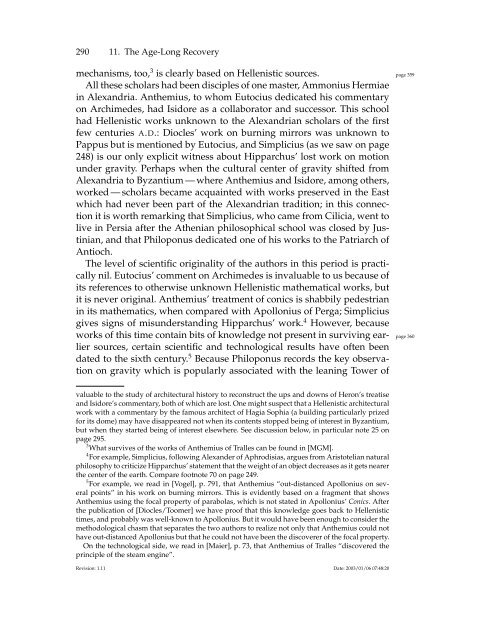1 The Birth of Science - MSRI
1 The Birth of Science - MSRI
1 The Birth of Science - MSRI
Create successful ePaper yourself
Turn your PDF publications into a flip-book with our unique Google optimized e-Paper software.
290 11. <strong>The</strong> Age-Long Recovery<br />
mechanisms, too, 3 is clearly based on Hellenistic sources. page 359<br />
All these scholars had been disciples <strong>of</strong> one master, Ammonius Hermiae<br />
in Alexandria. Anthemius, to whom Eutocius dedicated his commentary<br />
on Archimedes, had Isidore as a collaborator and successor. This school<br />
had Hellenistic works unknown to the Alexandrian scholars <strong>of</strong> the first<br />
few centuries A.D.: Diocles’ work on burning mirrors was unknown to<br />
Pappus but is mentioned by Eutocius, and Simplicius (as we saw on page<br />
248) is our only explicit witness about Hipparchus’ lost work on motion<br />
under gravity. Perhaps when the cultural center <strong>of</strong> gravity shifted from<br />
Alexandria to Byzantium — where Anthemius and Isidore, among others,<br />
worked — scholars became acquainted with works preserved in the East<br />
which had never been part <strong>of</strong> the Alexandrian tradition; in this connection<br />
it is worth remarking that Simplicius, who came from Cilicia, went to<br />
live in Persia after the Athenian philosophical school was closed by Justinian,<br />
and that Philoponus dedicated one <strong>of</strong> his works to the Patriarch <strong>of</strong><br />
Antioch.<br />
<strong>The</strong> level <strong>of</strong> scientific originality <strong>of</strong> the authors in this period is practically<br />
nil. Eutocius’ comment on Archimedes is invaluable to us because <strong>of</strong><br />
its references to otherwise unknown Hellenistic mathematical works, but<br />
it is never original. Anthemius’ treatment <strong>of</strong> conics is shabbily pedestrian<br />
in its mathematics, when compared with Apollonius <strong>of</strong> Perga; Simplicius<br />
gives signs <strong>of</strong> misunderstanding Hipparchus’ work. 4 However, because<br />
works <strong>of</strong> this time contain bits <strong>of</strong> knowledge not present in surviving ear- page 360<br />
lier sources, certain scientific and technological results have <strong>of</strong>ten been<br />
dated to the sixth century. 5 Because Philoponus records the key observation<br />
on gravity which is popularly associated with the leaning Tower <strong>of</strong><br />
valuable to the study <strong>of</strong> architectural history to reconstruct the ups and downs <strong>of</strong> Heron’s treatise<br />
and Isidore’s commentary, both <strong>of</strong> which are lost. One might suspect that a Hellenistic architectural<br />
work with a commentary by the famous architect <strong>of</strong> Hagia Sophia (a building particularly prized<br />
for its dome) may have disappeared not when its contents stopped being <strong>of</strong> interest in Byzantium,<br />
but when they started being <strong>of</strong> interest elsewhere. See discussion below, in particular note 25 on<br />
page 295.<br />
3 What survives <strong>of</strong> the works <strong>of</strong> Anthemius <strong>of</strong> Tralles can be found in [MGM].<br />
4 For example, Simplicius, following Alexander <strong>of</strong> Aphrodisias, argues from Aristotelian natural<br />
philosophy to criticize Hipparchus’ statement that the weight <strong>of</strong> an object decreases as it gets nearer<br />
the center <strong>of</strong> the earth. Compare footnote 70 on page 249.<br />
5 For example, we read in [Vogel], p. 791, that Anthemius “out-distanced Apollonius on several<br />
points” in his work on burning mirrors. This is evidently based on a fragment that shows<br />
Anthemius using the focal property <strong>of</strong> parabolas, which is not stated in Apollonius’ Conics. After<br />
the publication <strong>of</strong> [Diocles/Toomer] we have pro<strong>of</strong> that this knowledge goes back to Hellenistic<br />
times, and probably was well-known to Apollonius. But it would have been enough to consider the<br />
methodological chasm that separates the two authors to realize not only that Anthemius could not<br />
have out-distanced Apollonius but that he could not have been the discoverer <strong>of</strong> the focal property.<br />
On the technological side, we read in [Maier], p. 73, that Anthemius <strong>of</strong> Tralles “discovered the<br />
principle <strong>of</strong> the steam engine”.<br />
Revision: 1.11 Date: 2003/01/06 07:48:20










